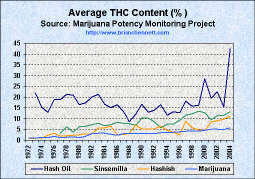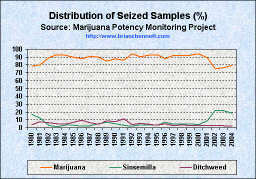|
It appears that Mr Walters is given to histrionics, or of simply being at best disingenuous, at worst a bald-faced liar. Clearly, significantly powerful cannabis preparations have been available for decades. If we narrow our focus to just "marijuana," the lowest recorded average potency was measured in 1973 at 0.83 percent THC. By contrast, the highest recorded average potency for "marijuana" was measured in 2004 at 5.81 percent THC. These numbers indicate that today's "marijuana" weighs in at well less than "10 to 20" times as potent as that from the last generation. Bear in mind though, that these are average THC content measurements -- not maximum "record strengths."
Of more importance however, is the idea that your "children" are obtaining and smoking "super weed." Are they really? The chart on the right shows the percentage of tested cannabis samples and indicates that by far most of the pot seized (and presumably most of the pot available on the market) is classed as "marijuana," the very same stuff Mr Walter's tells us is a "threat" to our children.
In reality, most of what "kids" are smoking is probably low grade cheap commercial Mexican marijuana -- the same stuff we grew up on. Why would that be so? Because higher potency pot is much more expensive than the widely available commercial pot. The scenario for pot use among our young people is likely akin to what young people do with alcohol use: buy the most volume for the buck. We all did the same thing, so why would today's kids be doing anything significantly different?
Most importantly, in practical terms, what is it about higher potency marijuana products that makes Mr Walter's hit the panic button? For a bit of perspective, perhaps we can do a brief comparison of cannabis products with their alcohol counterparts. After all, alcohol products are available in a wide variety of forms and potencies, and the high potency stuff is less likely to be available to young people (or desired by them for that matter), than the lower potency stuff.
Indeed, one pot smoker quoted in the 1972 Newsweek article quoted above had this to say after using hash oil (concentrated THC -- the active principle ingredient of marijuana): "It's not a heavy trip or a grass thing. It's just weird and sort of intense. Who needs to get that stoned?" Apparently, some people do -- and they have been doing so for a very long time.
|

